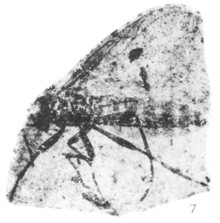Plecia avus
| Plecia avus | |
|---|---|

| |
| Plecia avus hypotype fossil
| |
| Scientific classification | |
| Domain: | Eukaryota |
| Kingdom: | Animalia |
| Phylum: | Arthropoda |
| Class: | Insecta |
| Order: | Diptera |
| Family: | Bibionidae |
| Genus: | Plecia |
| Species: | †P. avus
|
| Binomial name | |
| †Plecia avus (Handlirsch, 1910)
| |
| Synonyms | |
| |
Plecia avus is an extinct species of
History & classification
The holotype fossil of Plecia avus was collected by Lawrence Lambe from outcrops of the Allenby Formation along the Tulameen River on 6 August 1906, and then subsequently described by Anton Handlirsch in 1910. The type description was published in his Canadian fossil Insects. 5. Insects from the Tertiary lake deposits of the southern interior of British Columbia, along with a series of 19 other bibionid species. Handlirsch did not include the etymological derivation of species names in the volume.[2]
While reviewing the tertiary fossil bibionids of the Eocene Okanagan Highlands, Rice (1959) transferred almost all of the species described by Handlirsch from the genus
Distribution
Plecia avus has been recovered from up to four locations in the Okanagan highlands, with the holotype, GSC No. 7265, type locality being on the Tulameen River "opposite Vermilion Cliff" in the Allenby Formation near Princeton, British Columbia.[2] H. M. Rice (1959) subsequently identified four additional fossils from the Driftwood Shales near Smithers and another from Tranquille Creek near Cache Creek.[1]
Description

The wings of Plecia avus are on average between 8.6–10.1 mm (0.34–0.40 in) long and 3.3–3.7 mm (0.13–0.15 in) wide giving them a "narrower" appearance. The costal edge of the wing is only distinctly curved and most specimens show an indentation along the wing edge when the subcostal vein terminates. In specimens where the wing apex is known the acute wing tip symmetrical. The R3+4 fork of the radial vein is of moderate long in length and only narrowly diverges from the R5. The anterior cross vein joins the Rs vein close to where it forks, and the space between the anterior cross vein and costal is 0.9–1.15 mm (0.035–0.045 in), being slightly elongated by the narrow wing profile.[1]
Paleoecology
The Okanagan Highland sites represent upland lake systems that were surrounded by a warm temperate ecosystem with nearby volcanism.
Estimates of the mean annual temperature have been derived from climate leaf analysis multivariate program (CLAMP) analysis and leaf margin analysis (LMA) the Princeton paleoflora. The CLAMP results after multiple linear regressions for Princeton's gave a 5.1 °C (41.2 °F), and the LMA returned a mean annual temperature of 5.1 ± 2.2 °C (41.2 ± 4.0 °F). This is lower than the mean annual temperature estimates given for the coastal Puget Group, which is estimated to have been between 15–18.6 °C (59.0–65.5 °F). The bioclimatic analysis for Princeton suggest mean annual precipitation amount of 114 ± 42 cm (45 ± 17 in).[4]
References
- ^ doi:10.4095/100564.
- ^ a b Handlirsch, A. (1910). "Canadian fossil Insects. 5. Insects from the Tertiary lake deposits of the southern interior of British Columbia, collected by Mr. Lawrence M. Lambe, in 1906". Contributions to Canadian Palaeontology. 2 (3): 93–129.
- ^ Archibald, S.; Greenwood, D.; Smith, R.; Mathewes, R.; Basinger, J. (2011). "Great Canadian Lagerstätten 1. Early Eocene Lagerstätten of the Okanagan Highlands (British Columbia and Washington State)". Geoscience Canada. 38 (4): 155–164.
- ^ doi:10.1139/e04-100.
External links
 Media related to Plecia avus at Wikimedia Commons
Media related to Plecia avus at Wikimedia Commons
